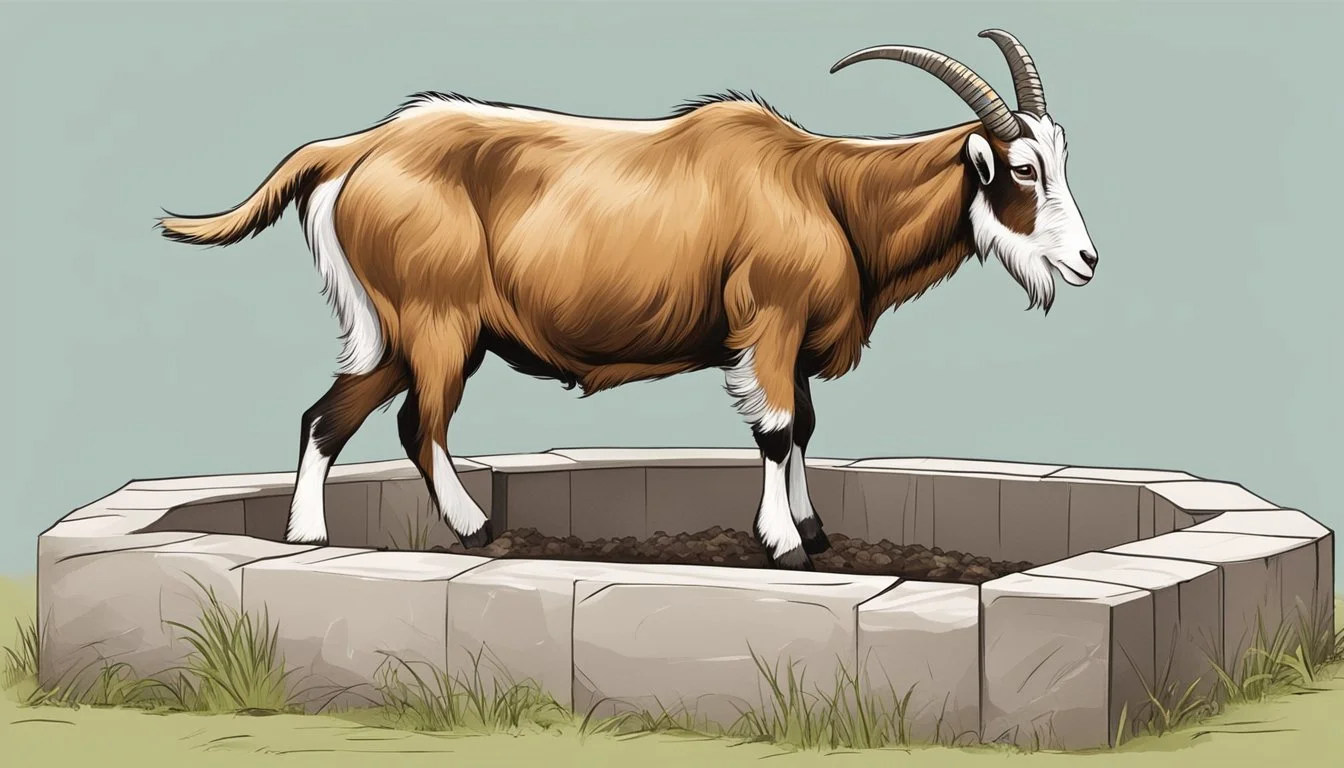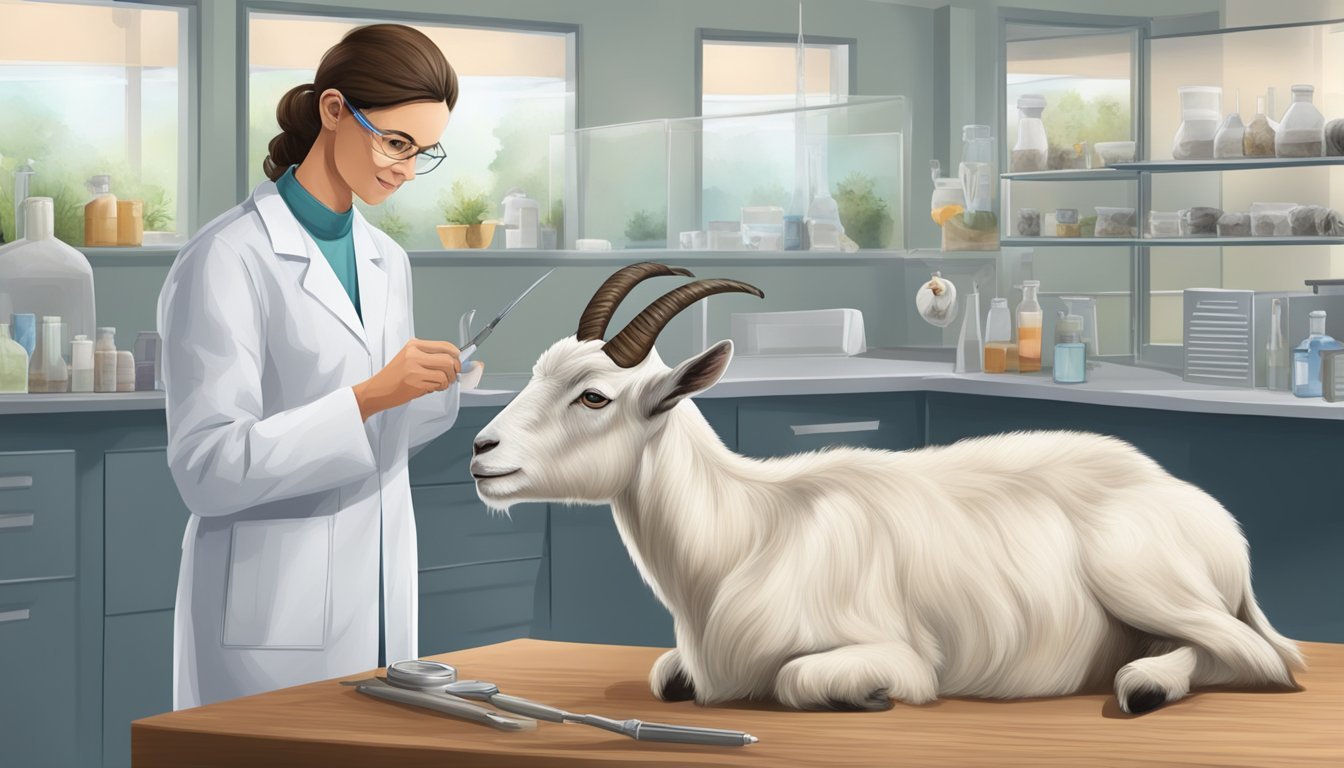Managing Goat Health
Effective Strategies for Disease Prevention and Treatment
Goat farming plays a significant role in the agricultural sector, with these hardy animals being raised for meat, milk, and fiber. As with any livestock, maintaining goat health is critical for the welfare of the animals and the profitability of the farm. Goats require proper preventive care and quick response to ailments to thrive. Goat producers must be vigilant about managing common health issues that can arise, such as parasitic infections, respiratory conditions, and hoof problems.
Preventive health care and husbandry are the cornerstones of effective goat management. Providing goats with clean, dry, and spacious shelter is essential to safeguard them against weather extremes and disease. Regular health checks, balanced nutrition, and adequate housing can keep most problems at bay. When illnesses do occur, early intervention is crucial. Treatment protocols for common diseases like footrot or parasitic infections need to be established, alongside strategies to prevent these ailments from spreading.
A comprehensive approach to managing goat health also includes vaccination programs and biosecurity measures to prevent infectious diseases. Staying informed about the best practices in goat care, such as those discussed in the Merck Veterinary Manual and advice from agricultural extensions like Penn State Extension, can help goat keepers navigate the complexities of goat health effectively.
Understanding Goat Physiology and Behavior
To properly manage goat health, it's essential to understand their unique physiological characteristics and how their behavior can signal health issues.
Goat Anatomy and Health Parameters
Goat Physiology has distinctive features that dictate their health and wellbeing. For example, their body temperature typically ranges from 102 to 103 degrees Fahrenheit, which is higher than that of humans. Their heart rate generally lies between 70 to 90 beats per minute, and respiratory rates should be about 12 to 20 breaths per minute. Familiarity with these parameters helps caretakers identify when a goat is unwell.
Pulse Rate: 70-90 beats/minute
Respiratory Rate: 12-20 breaths/minute
Body Temperature: 102-103°F
Behavioral Indicators of Ailments
Goat behavior can offer immediate clues to their health status. A healthy goat is usually alert and active with a strong appetite. Behavioral changes are often the first sign of disease. For instance, a goat that is lethargic or less interactive with the herd may be ill.
Appetite: Decrease can indicate health issues.
Activity Level: Drop may suggest discomfort or pain.
Social Behavior: Isolation could be a sign of a problem.
It is through close observation of these behaviors that preventable diseases such as pneumonia and parasites may be swiftly addressed. Keeping a vigilant eye on each goat's behavior and physical condition is critical for early intervention and treatment.
Optimal Goat Nutrition and Diet
To maintain good health and productivity, goats require a diet that meets their nutritional needs.
Feeding for Preventative Health
Goats thrive on a balanced diet that provides essential nutrients and helps prevent common health issues. High-quality forage, such as pasture, hay, or silage, is the cornerstone of a goat's diet. They should consume approximately 1.8%-2.0% of their body weight in dry matter each day. Forage with a crude protein concentration of 7%-9% and a total digestible nutrition (TDN) value of around 50% supports basic maintenance needs.
Nutrients and Supplements
Goats need a mix of nutrients, which include:
Proteins: Crucial for growth, reproduction, and milk production.
Vitamins & Minerals: Essentials like calcium, phosphorus, and vitamins A, D, and E support bone health and vital body functions.
Energy: Carbohydrates and fats in the diet provide energy, especially important during lactation or growth periods.
A balanced diet for goats may also include supplements, particularly when high-quality forage is scarce or when the animals are under higher production demands—such as lactation or growth spurts. Providing a mineral mix or specific vitamin supplements as needed can help fill any nutritional gaps in their diet.
Common Health Issues and Ailments in Goats
Goat owners should be aware that health management is a vital aspect of goat farming, encompassing various diseases and conditions that can affect the herd. Effective identification and treatment of common ailments are essential for maintaining a healthy flock.
Overview of Goat Diseases
A broad spectrum of diseases can impact goats, ranging from parasitic infections to bacterial and viral illnesses. Internal parasites, such as stomach worms, can cause anemia and weakness, while external parasites like lice and mites can lead to skin irritation and coat damage. Abscesses, often resulting from infection with Caseous Lymphadenitis, can cause swelling and discomfort. Arthritis and neurological conditions such as Encephalitis or Caprine Arthritis Encephalitis (CAE) are also seen in goats, often leading to pain and mobility issues.
Parasites: Anemia, weight loss, coat deterioration
Abscesses/Caseous Lymphadenitis: Swelling, pus
Arthritis/Encephalitis/CAE: Joint pain, behavioral changes
Symptoms and Diagnosis of Ailments
Recognizing the signs of an ailment in goats is crucial for timely intervention. Symptoms such as diarrhea, coughing, fever, and sudden death can indicate serious health concerns. Abdominal pain and convulsions may suggest advanced conditions requiring immediate veterinary attention. Diagnosing goat diseases typically involves a combination of clinical signs, laboratory tests, and sometimes necropsy in cases of unexplained deaths.
Common Symptoms: Diarrhea, coughing, fever
Severe Symptoms: Abdominal pain, convulsions
Diagnosis Methods: Clinical signs, laboratory tests
Specific Conditions and Their Management
Contagious Ecthyma, also known as Orf, presents with scabby lesions on the lips and around the mouth, resulting in feeding difficulties. Interventions include separating infected animals and practicing good hygiene. Overeating disease is characterized by a rapid onset of neurologic signs, including convulsions and often leading to sudden death; vaccination is an essential preventative measure. Parasite control is a cornerstone of goat health management; deworming strategies and pasture rotation are regularly used to reduce the parasite load.
Contagious Ecthyma/Orf: Lesions, separation, hygiene
Overeating Disease: Convulsions, sudden death, vaccination
Parasite Control: Deworming, pasture management
Goat Reproductive Health
Managing reproductive health is vital for a successful goat farming operation. It includes understanding the intricacies of breeding cycles and recognizing common disorders that can affect fertility and kidding outcomes.
Breeding and Kidding
Breeding in goats should be planned with careful attention to timing, allowing for optimal fertility and ease of kidding. Ultrasonography is a valuable tool for monitoring fetal development and can help in managing the doe's diet during late gestation based on fetus count. Kidding, or the process of giving birth in goats, usually occurs after a gestation period of approximately 150 days. Does should have access to exercise and proper nutrition throughout their pregnancy to ensure healthy offspring and minimize complications.
Breeding Seasonality: Goats are seasonally polyestrous, and breeders must plan for this.
Gestation Care: Increased nutritional needs during gestation are critical for healthy kidding.
Common Reproductive Disorders
Several reproductive disorders can compromise the health of goats:
Dystocia: Difficult labor can occur, necessitating intervention.
Endometritis: Inflammation of the uterine lining post-kidding may lead to fertility issues.
Prompt identification and treatment of these and other reproductive disorders are necessary to maintain the well-being of breeding does and ensure the viability of the offspring. Regular health check-ups and preventative care can help mitigate the risks associated with common reproductive disorders and promote a thriving goat population.
Best Practices in Goat Farming
Effective goat farming hinges on stringent health management and preventive care, focusing on a comprehensive approach to herd management, biosecurity, routine health care, and meticulous record-keeping.
Herd Management
Herd management should prioritize the health and well-being of the goats. Stress minimization is crucial; it can be achieved by providing adequate space, proper bedding, and a comfortable environment for the goats. Regular health checks are essential to detect any signs of illness early. Necropsy examinations can be key in understanding the cause of deaths which aids in preventing future losses.
Environmental Controls and Biosecurity
Environmental controls ensure proper ventilation, which is vital for maintaining good air quality and reducing the buildup of harmful gases. Strict biosecurity measures help prevent the introduction and spread of diseases. Measures include sanitation protocols, control of farm access, and quarantine procedures for new or sick animals.
Routine Health Care Procedures
Preventative health care includes regular vaccinations per an established vaccination schedule and hoof trimming to prevent lameness. Partnering with a veterinarian ensures proper health care and disease prevention strategies are in place. Goat farming benefits from a proactive approach to health care to ensure any potential issues are addressed before becoming serious.
Record Keeping and Monitoring
Accurate record keeping and monitoring are indispensable for tracking the health, vaccination, and treatment histories of each goat. Records should include dates of health checks, signs of illness, and all preventive measures taken. A diligent record-keeping system supports effective management practices and can serve as a reference for biosecurity evaluations and planning.
Monitoring and Treating Parasitic Infections
Effective management of parasitic infections in goats is essential for maintaining their health and productivity. This section will cover the critical steps of identifying parasite infestations in goats and the treatment and control strategies to mitigate them.
Identifying Parasite Infestations
Goat producers must be vigilant in detecting the signs of parasitic diseases. Specific tests can diagnose the presence of parasites, including fecal egg count tests to assess the load of gastrointestinal worms. Common symptoms indicating an infestation might include anemia, diarrhea, and decreased appetite. Goats are often affected by a variety of parasites such as tapeworms, liver flukes, protozoa, and nematodes.
Treatment and Control Strategies
Once an infestation is identified, treatment should commence promptly. Anthelmintics are medications used to treat infections caused by worms and other internal parasites. A strategic deworming schedule can greatly reduce the parasite burden; however, it's crucial to use these treatments responsibly to prevent resistance. Flukicides are used specifically for flukes. To control external parasites like ticks, acaricides can be employed. Along with treatments, environmental management, such as rotating pastures and controlling grazing density, plays a crucial role in maintaining a low level of parasites. For in-depth guidelines, please refer to the Cornell University document on parasite management and control. Additionally, information on common diseases, including parasitic infections, can be found in the Merck Veterinary Manual.
Addressing Contagious Diseases and Prevention
Managing health in goats involves understanding and preventing the spread of contagious diseases. Key strategies include vaccination, maintaining hygienic conditions, and monitoring for signs of illness.
Caseous Lymphadenitis (CL) Management
Caseous Lymphadenitis, a chronic condition characterized by abscesses in lymph nodes, is caused by a bacterial infection. Good hygiene practices and proper disposal of pus from infected wounds are critical to reduce the risk of spreading CL. When abscesses are present, isolating affected goats is essential to prevent direct contact and transmission. Regular veterinarian check-ups for early detection and management can help contain the disease.
Preventing Contagious Ecthyma (Orf)
Contagious Ecthyma, commonly known as Orf, is a viral infection that results in scabby sores typically around the mouth and nostrils. It’s not only painful for goats, but also contagious to other animals and humans. To prevent Orf, avoid introducing new goats to the herd without proper quarantine and apply strict biosecurity measures. Vaccination can be considered, especially in herds with a history of the disease.
Controlling Caprine Arthritis Encephalitis (CAE)
An effective strategy against Caprine Arthritis Encephalitis (CAE) includes regular blood testing and removing infected animals from the herd. CAE is a contagious, chronic disease that affects the joints and, in some cases, the nervous system. Disease prevention is aided by separating kids from infected does at birth to avoid transmission through milk. Ensuring clean housing and using only sterilized equipment for all goats will reduce the risk of CAE transmission.
Enhancing Goat Production
To maintain a profitable and sustainable goat farming operation, attention must be paid to enhancing meat and milk production, managing animal welfare to minimize stress, and understanding market demands for goat products.
Maximizing Meat and Milk Yield
Farmers can increase productivity by selecting breeds known for higher meat and milk yield, such as the dairy goat. Proper nutrition that is rich in energy and protein is essential, particularly for does in lactation and kids experiencing rapid growth. Monitoring body condition and managing forage can help prevent weight loss and promote steady growth, supporting higher production volumes.
Welfare and Stress Minimization
Animal welfare directly impacts productivity; thus, farmers must provide clean, dry shelter and manage stress factors like overcrowding and extreme weather. Adequate ventilation and good husbandry practices such as regular hoof trimming and parasite control can prevent diseases like footrot and poor growth due to illnesses.
Market-Oriented Goat Farming
Understanding supply and demand dynamics in the market guides producers to tailor their farming practices effectively. Predators can cause significant loss; hence, effective management benefits the security of the herd and, consequently, meat productivity. Similarly, diversifying into fiber production from breeds like Angora goats can cater to different market needs beside meat and milk, offering alternative revenue streams.
Integrating Veterinary Support and Treatments
Integrating veterinary support plays a critical role in the ongoing health management of goat herds. It ensures access to professional healthcare and tailored treatments, including vaccinations and the use of antibiotics when necessary.
Routine Health Examinations and Vaccinations
Routine health examinations are pivotal in maintaining the welfare of a goat herd. These examinations should be carried out by a qualified veterinarian, who can assess each animal's health and administer necessary vaccinations. Vaccinations protect against common diseases such as Caprine arthritis encephalitis, as indicated in the Merck Veterinary Manual, and should be part of a standardized health care regimen. They serve to reduce the likelihood of disease outbreaks and the subsequent need for treatments, which can include antibiotics and other medications.
Advanced Diagnostics and Treatment Options
When goats fall ill, veterinarians provide advanced diagnostics to pinpoint the exact issues at hand. These may include laboratory testing, imaging scans, or biopsies. Based on the diagnosis, a treatment plan is formulated, which may involve treatment approaches such as:
Antibiotics: Used to treat bacterial infections, with specificity towards the causative agent to reduce the risk of antibiotic resistance
Antiparasitics: Essential for the control of internal and external parasites
Supportive care: Such as fluid therapy and nutritional support to bolster a goat's health during recovery
Each intervention is chosen based on its efficacy for the particular ailment, always with a view to promoting quick recovery and minimal distress to the animal.
Establishing Effective Management and Husbandry Practices
Effective management and husbandry are critical to maintaining a healthy goat herd. Attention to detail in infrastructure and health scheduling ensures optimal health and production.
Infrastructure and Space Requirements
Goats require shelter that provides protection from weather extremes while maintaining cleanliness and adequate space to prevent stress and disease. Shelters should be designed to offer:
Proper Ventilation: To avoid overheating and reduce ammonia buildup, shelters must be well-ventilated.
Dry Bedding: Bedding should be kept dry and replaced regularly to prevent the growth of pathogens.
Sufficient Space: Overcrowding should be avoided to reduce stress and the spread of disease among the herd.
An appropriate environment is conducive to the health and wellbeing of goats, influencing milk production and overall herd health.
Herd Health Scheduling and Procedures
Maintaining a scheduled health program is paramount for disease prevention and health care. Key elements include:
Regular Health Checks: Frequent examinations to monitor for signs of illness or injury.
Vaccination Programs: Implementing a tailored vaccination protocol to prevent common diseases.
Parasite Control: Effective management practices to prevent and control parasitic infections.
Nutrition: Ensuring a balanced diet to support health and production.
A herd health program is essential, with regular consultations with a veterinarian to adapt to the specific needs of the goat herd.








